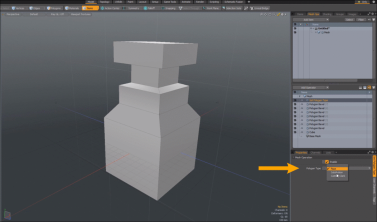Search is based on keyword.
Ex: "Procedures"
Do not search with natural language
Ex: "How do I write a new procedure?"
Set Polygon Type
The Set Polygon Type tool is a procedural mesh operation that allows you to convert polygons at any point in your design workflow. It can be applied on any surface polygons or a selection of surface polygons by selecting the mesh item in your Mesh Operations list and changing the type of polygon used. Polygons can be quickly converted into Faces, Subdivision, or Catmull-Clark polygons. If the initial polygon type matches the selected type, no operation is performed. All parameters of the polygons, such as vertex maps and polygon tags, are maintained.
The Set Polygon Type tool is found in the Mesh Ops tab, located on the right side of the interface. Click Add Operator, expand Mesh Operations > Polygon and double-click Set Polygon Type.
To apply the Set Polygon Type tool:
| 1. | Open the Model layout. |
| 2. | On the right panel of the interface, open the Mesh Ops tab. |
| 3. | From the Mesh Operations list, select a mesh item. |
| 4. | Click Add Operator, expand Mesh Operations > Polygon, and select Set Polygon Type. |
| 5. | In the Properties tab, select a Polygon Type. |
The updated mesh is displayed in the 3D viewport.
To disable the Set Polygon Type tool:
| 1. | Select the Set Polygon Type item in the Mesh Operations list. |
| 2. | Click the Enable button. |
Set Polygon Type Property Options
The following options are available:
|
Option |
Description |
|
Enable |
Enables or disables the set Polygon Type. This gives you a similar workflow as Direct Modeling when pressing Shift + Tab or Tab. |
|
Allows you to specify the type of polygon to convert to. The following options are available: Face - Creates a faceted surface. This is the default value. Tip: An individual polygon is commonly called a face, which is bounded by three or more vertices and their associated edges. When many faces are connected together to create a network of it's faces called a polygon mesh. Subdivision - Creates a smoother surface. Tip: Subdivision smooths and adds extra resolution to curves and surfaces. Catmull-Clark - Converts any surface into a Catmull-Clark Subdivision Surface. Tip: The Catmull-Clark Subdivision Surfaces are superior to regular Subdivision Surfaces, especially in their handling of edge creasing. For more information about Catmull-Clark options, see Mesh Item. |
Sorry you didn't find this helpful
Why wasn't this helpful? (check all that apply)
Thanks for your feedback.
If you can't find what you're looking for or you have a workflow question, please try Foundry Support.
If you have any thoughts on how we can improve our learning content, please email the Documentation team using the button below.
Thanks for taking time to give us feedback.
